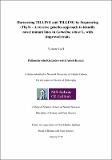| dc.contributor.advisor | Spillane, Charles | |
| dc.contributor.author | Pullanchyottu Kizhakkeveettil, Anish Kumar | |
| dc.date.accessioned | 2018-02-12T11:02:12Z | |
| dc.date.issued | 2018-02-09 | |
| dc.identifier.uri | http://hdl.handle.net/10379/7132 | |
| dc.description.abstract | Camelina sativa L. is a neglected biofuel crop with potential for tremendous application in
various industries due to its varied oil traits, which increases the scope of crop improvement.
Camelina is an allo-hexaploid with a chromosome number of 40 (2n) and a genome size of
642MB. We evaluated TILLING technique to carry out Camelina crop improvement by focusing
on genes controlling overall oil quality and other non-nutritive traits. TILLING by enzyme was
done in FAD2 or fatty acid desaturase 2, which controls the conversion of oleic acids (C18:1) to
linoleic acid (C18:2); and FAE1 or fatty acid elongase 1, which sequentially adds two carbon
units to 18-carbon fatty acids thereby forming very long chain fatty acids (VLCFAs). A total
number of 22 mutants were obtained, 11 each in FAD2 and FAE1 gene. TILLING in FAD2 and
FAE1 genes showed a mutation frequency rate of 1 per 520 kb and 1 per 682 kb respectively;
and an overall mutation frequency of 601 kb. A novel mutant with zero erucic acid was
developed by this approach.
TILLING by sequencing (TbyS) was also done for genes affecting the lipid biosynthesis
pathway (FAD2 and FAE1) and the function of non-nutritive traits MIPS1 (myo-inositol-1-
phosphate synthase), and TGG1 (thiogucoside glucohydrolase 1), we obtained 183 mutants from
the 2496 M2 mutant population. Mutation frequency in each gene were as follows, for FAD2 – 1
per 40 kb, FAE1 – 1 per 40, MIPS1 – 1 per 106 kb, and TGG1 1 per 145 kb giving an overall
mutation frequency of 1 per 55 kb. Phenotyping morphologically showed an overall percentage
of 9.6% various phenotypes after screening 5049 M2 families, in which a total of 1.1% of M2
families showed albino plants. The mutants generated from the present study have a potential for
food and non-food applications. | en_IE |
| dc.rights | Attribution-NonCommercial-NoDerivs 3.0 Ireland | |
| dc.rights.uri | https://creativecommons.org/licenses/by-nc-nd/3.0/ie/ | |
| dc.subject | TILLING | en_IE |
| dc.subject | TILLING by sequencing (TbyS) | en_IE |
| dc.subject | Camelina | en_IE |
| dc.subject | Biofuel | en_IE |
| dc.subject | Plant science | en_IE |
| dc.subject | Natural sciences | en_IE |
| dc.subject | Agri-biosciences | en_IE |
| dc.title | Harnessing TILLING and TILLING by Sequencing (TbyS) - A reverse genetics approach to identify novel mutant lines in Camelina sativa L. with improved traits | en_IE |
| dc.type | Thesis | en_IE |
| dc.local.note | Camelina sativa is a Biofuel crop which has been improved by a biotechnological techique, i.e. TILLING. We developed zero erucic lines by non-transgenic method which includes conventional mutation breeding and sequencing technology, which have tremendous application in both food and non-food industries.
The camelina mutant population developed in the present study will be a useful resource for plant molecular breeders ultimately enhancing farming community.. | en_IE |
| dc.description.embargo | 2020-02-09 | |
| dc.local.final | Yes | en_IE |
| nui.item.downloads | 750 | |


